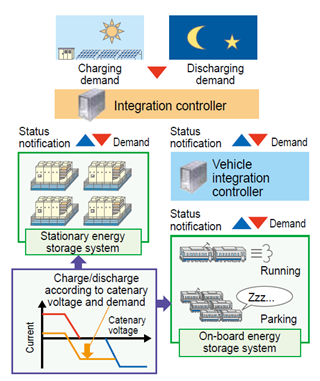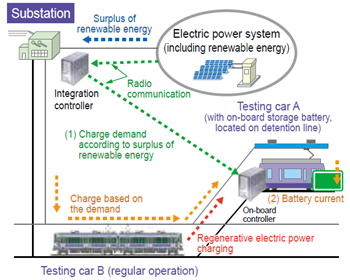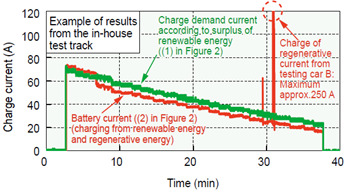21. Integrated Control Method for Railway Energy Storage Systems Enabling the Use of Renewable Energy
Energy storage systems for DC traction power supply systems are mainly introduced for energy saving by absorbing regenerative energy, and for use as emergency power sources. We explored the stable utilization of renewable energy, which fluctuates significantly depending on the time of day, by coordinating the charge/discharge control between fixed installation systems and on-board systems.
We developed an algorithm that integrally controls the charge/discharge of railway energy storage systems according to the amount of surplus renewable energy (Figure 1). In this algorithm, the integration controller distributes charge/discharge demands to the controllers of each energy storage system in a way that equalizes their state of charge as much as possible. To evaluate the effectiveness of the developed algorithm, we implemented a control function to charge/discharge an on-board energy storage system on a single train set, triggered by charge/discharge demands (Figure 2) and made several tests on the test track at the Institute. As a result of tests assuming a surplus of renewable energy, we demonstrated it is possible to charge the on-board storage battery with a surplus of the renewable energy based on the current demand from the integration controller, as well as charging regenerative electric power of another running vehicle as needed (Figure 3).
This method is expected to contribute to the realization of a decarbonized society by increasing the amount of renewable energy that can be utilized through railway energy storage systems.
Other Contents
- 19. Two-Step Cross-Sectional Tunnel Entrance Hood
- 20. Method for Detailed Prediction of Contribution of Each Noise Source on Wayside Noise Generated by Shinkansen Vehicles
- 21. Integrated Control Method for Railway Energy Storage Systems Enabling the Use of Renewable Energy
- 22. Development and Commercial Operation Demonstration of High-capacity Superconducting Feeding for Urban Commuter Lines
- 23. Safety Assessment of Hydrogen Fuel Cell Multiple Units
- 19. Two-Step Cross-Sectional Tunnel Entrance Hood
- 20. Method for Detailed Prediction of Contribution of Each Noise Source on Wayside Noise Generated by Shinkansen Vehicles
- 21. Integrated Control Method for Railway Energy Storage Systems Enabling the Use of Renewable Energy
- 22. Development and Commercial Operation Demonstration of High-capacity Superconducting Feeding for Urban Commuter Lines
- 23. Safety Assessment of Hydrogen Fuel Cell Multiple Units



